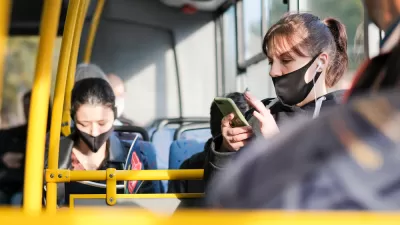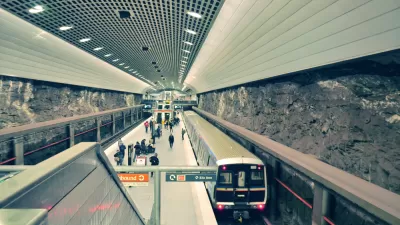While the future of transit ridership depends on a range of still-uncertain factors, the commuter-centric patterns that characterized pre-COVID transit service are probably a thing of the past.

Writing in Seattle Transit Blog, Sherwin Lee acknowledges the uncertainty of the future of post-COVID public transit. “Two years into the pandemic and counting, it’s fairly evident that there has been and will be no ‘v-shaped’ recovery for transit ridership,” Lee writes. “The issue is that many of the variables that go into ridership projections are still riddled with near-term uncertainty,” making it difficult to make any confident predictions about post-pandemic ridership.
But there are some trends worth noting. “Here’s a crude back-of-the-napkin analysis for calculating potential lost ridership: Roughly half of pre-COVID ridership was commuters, of which we might assume a third will now be fully remote, another third will be hybrid (commuting a few days a week), and the remaining third will go back to the office mostly full-time. Rounding out the math, that gives us a quarter of trips that will disappear forever.” Bolstering Lee’s point, “According to APTA, nationwide ridership is still hovering about 50-60% of pre-pandemic levels.”
For Lee, “What does matter is that cities and transit agencies immediately adapt to our new housing and land use reality.” For Lee, this means reducing their reliance on commuters and “downsizing peak-only services and building up frequent all-day cross-town connections,” as well as making more significant changes such as more diverse housing options and mixed-use development in more neighborhoods.
FULL STORY: What will be the new normal for post-COVID ridership?

Alabama: Trump Terminates Settlements for Black Communities Harmed By Raw Sewage
Trump deemed the landmark civil rights agreement “illegal DEI and environmental justice policy.”

Study: Maui’s Plan to Convert Vacation Rentals to Long-Term Housing Could Cause Nearly $1 Billion Economic Loss
The plan would reduce visitor accommodation by 25% resulting in 1,900 jobs lost.

Planetizen Federal Action Tracker
A weekly monitor of how Trump’s orders and actions are impacting planners and planning in America.

Wind Energy on the Rise Despite Federal Policy Reversal
The Trump administration is revoking federal support for renewable energy, but demand for new projects continues unabated.

Passengers Flock to Caltrain After Electrification
The new electric trains are running faster and more reliably, leading to strong ridership growth on the Bay Area rail system.

Texas Churches Rally Behind ‘Yes in God’s Back Yard’ Legislation
Religious leaders want the state to reduce zoning regulations to streamline leasing church-owned land to housing developers.
Urban Design for Planners 1: Software Tools
This six-course series explores essential urban design concepts using open source software and equips planners with the tools they need to participate fully in the urban design process.
Planning for Universal Design
Learn the tools for implementing Universal Design in planning regulations.
Caltrans
Smith Gee Studio
Institute for Housing and Urban Development Studies (IHS)
City of Grandview
Harvard GSD Executive Education
Toledo-Lucas County Plan Commissions
Salt Lake City
NYU Wagner Graduate School of Public Service





























